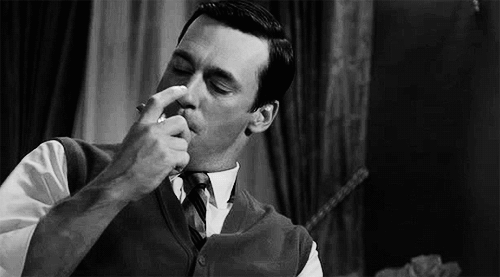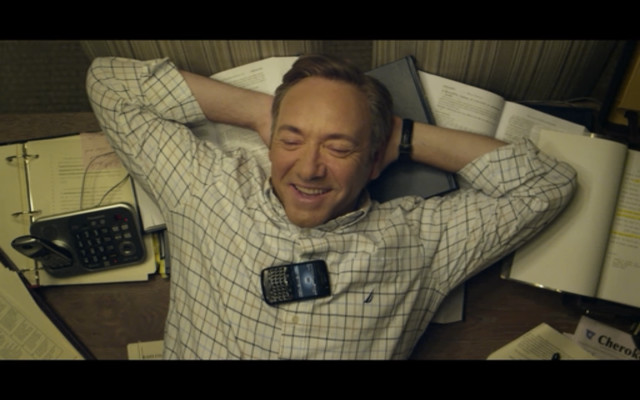Orange Is The New Black, House Of Cards, And The Myth Of Ad-Free Viewing
Navigate the geo-blocking, pay your Netflix subscription fee, and enjoy some ad-free television, right? Uh, don't be fooled.

While television on commercial networks can often be better described as “space between advertisements”, the business of ‘quality’ television content in America has increasingly become the pursuit of a few new players, signifying an exciting era of TV where content doesn’t have to be dictated by the whims of advertisers, 30-second spots and investors who might find offence with a particularly controversial storyline and limit the scope available for critique or debate. Finally, complex serials can be allowed to grow and develop without the spectre of nightly ratings and advertiser interests that dominate mainstream programming.
But is this truly a turning point for this new “golden age” of television? If the money doesn’t come from a 30-second spot for cereal, who’s going to pay for the ludicrously pricey productions costs of Boardwalk Empire, and its similarly expensive cohorts?
Pulling the plug on cable television
Cable providers offer the most effective platform for niche television — things like high drama and more discerning comedy. In order to view a channel like HBO or AMC, customers (only in America, mind you) must purchase a basic cable television package and then choose particular channels, of which HBO and AMC may be included. In this model, the content of such channels is only available to users that invest in the entire channel, with all of its time-locked and ‘Other TV Shows I Don’t Want To Watch’ shortcomings.
Furthermore, their content is still reliant on selling advertising space to supplement ailing subscription fees. Cable television and its time constraints is a dying market. Increasingly, the subscription revenue doesn’t seem enough to pay for the vodka on Don Draper’s desk, let alone the high-budget pull it usually takes to keep a show looking good enough for people to watch. AMC was so worried about their post Bad and Mad landscapes, they split the final seasons of both shows in half, a telling example of trying to eke as much out of these cash cows as possible.
HBO, the behemoth behind canonical works The Sopranos, The Wire and True Blood has no advertising, but charges higher subscription fees and trades upon the cultural cache earned from creating some of the most highly acclaimed and universally viewed television in history. In recent years, HBO has run into a major distribution problem. The loss in potential revenue in the international market has previously been tempered by a huge DVD market and (eventual) international syndication. The rise of internet streaming rendered the DVD to the same ranks of the cassette tape and the VHS, obsolete hardware in the face of media files that could be transferred over the net. The new digitised media allowed customers to demand greater flexibility, and eschew the networks which only allow a rigid and unchanging practise of viewing.
This shift to a digital distribution model reached a new critical mass when it surfaced that Game Of Thrones was the most illegally downloaded show in history. In modern television, Game Of Thrones is ubiquitous, although this devotion did not translate into the requisite cash cow that HBO may have expected. In producing this phenomenally expensive and acclaimed piece, they’re left with a hefty bill.
Enter Netflix
Initially a simple DVD mailing service, Netflix soon moved into internet streaming distribution. The company then outlined its intentions to the throne when it branched into original content exclusively broadcast through its website. Netflix represents ‘a version of HBO that’s directly available to consumers’ or the ‘supercharged HBO’, as it’s been described, conceived to out-home box office Home Box Office. This is like iTunes deciding to cut the middle man, and producing the next Justin Timberlake album.
At first glance, this is a triumph for TV writers and showrunners, who are liberated from the antiquated ratings/advertiser relationship and can be green-lit for multiple seasons at the outset. And even their pricing gauges are a steal: for just a minimal fee — which you can pay from Australia, via an easy work-around — you can access a virtual smorgasboard of old and new content, on demand, wherever and whenever you want it. But where do Netflix make their money to make the next big hit?
Ads, but not as you know them
So far, Netflix’s offerings range from intriguing to downright riveting. Making Arrested Development was a credibility no-brainer; making it of comparable quality to the original series was something else entirely. The political drama House Of Cards represents a different sleight of hand. Though outstanding, House Of Cards signifies a disturbing shift in the new landscape. The product placement is literally staggering. I mean literally. Didn’t notice it? That’s the point.
Critics posit that the shameless plugs are so seamlessly interwoven into the narrative you don’t even notice the highly dramatic advertising space, like if Times Square billboards started appearing within the Broadway theatres to pay for the shows. The deft inclusion of designer products as catalyst for major plot sequences is a surreal marketing practise — Don Draper would be pleased. How the hell else was a tiny distribution network like Netflix able to green-light two seasons of a show with two unbelievably expensive Hollywood heavyweights in Kevin Spacey and David Fincher (of American Beauty and Fight Club fame, respectively) that reportedly cost $100 million to make than by making the show itself the advertising?
But that’s standard industry fare, right? That’s just the way things get done. And shouldn’t we be happy that the advertising space was so watchable? In an industry that we ourselves, as viewers, crafted out of our own dissatisfaction with cable distribution, viewers are wary of the influence of commerce on quality work. Every episode of The Sopranos was littered with the sort of lavish lifestyle that only men of Tony Soprano’s peculiar penchant for the waste management services of New Jersey could possibly procure. On closer inspection, The Sopranos really was authenticity for authenticity’s sake. They didn’t receive payment for any of the product placement on the show. The producers were allegedly trying to retain the visual continuity, so they used San Pel and Coke and Lexus for staging purposes. This could be understood as hyperbole from a network that desperately wants to appear credible.
Netflix is noticeably sketchy on the amounts they’ve received, and seem like they want to stay out of the argument. In this post-advertising, post-cable TV world, how much content in House Of Cards is driven by a financial incentive? Or how much of the story will later be omitted for the depiction of a well-known product in an unflattering light? And that could be fine in this series, but what about the next or the next?
Product Placement Is The New Black
I’ve just finished watching Netflix’s newest offering, Orange Is The New Black (which begins airing locally on Foxtel’s Showcase tomorrow night). It’s great. In fact, holding form, it may become one of the most significant moments in the history of the medium (Grantland offers a succinct analysis of why this may be true). And there was only one blatant corporate tie-in so far: an attempt to subvert the prisoners’ burgeoning committee with the promise of Dunkin Donuts in their meetings. As a device for a wider narrative, the individual gratification symbolised by the donuts is countered by the prisoner’s responsibility to the collective.
Though isolated in incidence, it heralds a worrying precedent. Following the explosion of corporate furnishings in House Of Cards, to rely so heavily on the viewer’s semiotic relationship with a particular brand name or product utilises the ‘promotional furnishing’ as a potential source of revenue. Does quality storytelling necessitate a quest for brand association, or is the brand association the price we pay for quality storytelling?
For her successor to the wildly acclaimed Weeds, OITNB creator Jenji Kohan may have chosen Netflix for their upfront commitment (a guaranteed 13-episode season run and immediate renewal), countering the studio method that hinges on advertising interest and streams of revenue. HBO, meanwhile, faces the very real problem of how a once mighty studio deals with a cash flow problem to continue making the kinda shows that everyone talks about, but no one is prepared to pay for. I’m counting the product placement on Orange Is The New Black. But while counting, I’m still watching.
–
Brad is a writer from Melbourne who throws himself headlong into arguments about whatever people seem to be arguing about. Sometimes he writes about them.

